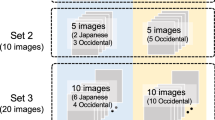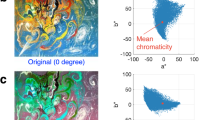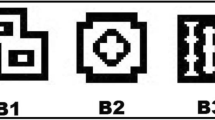Abstract
Birds have visual cognition as well developed as humans. Sometimes, the birds show visual discrimination similar to humans, but the birds may use different cues. Previous reports suggest that global configuration cues are salient for humans, whereas local elemental cues are salient for pigeons. I analyzed the discriminative behavior of pigeons with scrambled images because scrambled images keep the local elemental cues of the original images but lose the global configuration cues. If pigeons use local elemental cues, then, they should show transfer of discrimination from the original images to their scrambled images and also transfer from the scrambled images to their original images. In Experiment I, I trained pigeons on painting style discrimination (Japanese paintings vs. Western impressionist paintings) using either the original or scrambled images and found that the pigeons showed bidirectional transfer. In Experiment II, I trained pigeons on discrimination of “good” versus “bad” paintings using children’s paintings. The birds showed poor transfer from the original images to their scrambled images and vise versa. Thus, the pigeons discriminated good and bad paintings based mostly on global configuration cues in this case. These results suggest that the pigeons use different cues for different discriminations.







Similar content being viewed by others
References
Anderson JR, Kuwaharam H, Kuroshimma H, Leighty KA, Fujita K (2005) Are monkeys aesthetists? Rensch (1957) revisited. J Exp Psychol Anim Behav Proc 31:71–78
Aust U, Huber L (2001) The role of item- and category specific information in the discrimination of people versus nonpeople images by pigeons. Anim Learn Behav 29:107–119
Averbeck BB, Lee D (2004) Coding and transmission of information by neural ensembles. Trends Neurosci 27:225–230
Bichot NP, Rossi AF, Desimone R (2005) Parallel and serial neural mechanisms for visual search in macaque area V4. Science 308:529–534
Cavoto KK, Cook RG (2001) Cognitive precedence for local information in hierarchical stimulus processing by pigeons. J Exp Psychol Anim Behav Proc 27:3–16
Cela-Conde CJ, Marty G, Maestu F, Ortiz T, Munar E, Fernandez A, Roca M, Rossello J, Quesney F (2004) Sex-related similarities and differences in the neural correlates of beauty. PNAS 101:6321–6325
Cerella J (1980) The pigeon’s analysis of picture. Pattern Recognit 12:1–6
Delius JD, Habers G (1978) Symmetry: can pigeons conceptualize it? Behav Neural Biol 22:336–342
Draganiou TI, Nagle L, Kreutzer M (2002) Directional female preference for an exaggerated male trait in canary (Serinus canaria) song. Proc R Soc Lond B 269:2525–2531
Driscoll C (2006) The bowerbirds and the bees: miller on art, altruism, and sexual selection. Philos Psychol 19:507–526
Eibl-Eibesfeldt I (1988) The biological foundation of aesthetics. In: Rentschler I, Herzberger B, Epstein D (eds) Beauty and the brain—biological aspects of aesthetics. Birkhauser, Basel, pp 29–68
Gibson BM, Wasserman EA, Gosselin F, Schyns PG (2005) Applying bubbles to localize features that control pigeons’ visual discrimination behavior. J Exp Psychol Anim Behav Proc 31:376–382
Gosselin F, Schyns PG (2001) Bubbles: a technique to reveal the use of information in recognition task. Vis Res 41:2261–2271
Greene SL (1983) Feature memorization in pigeon concept formation. In: Commons ML, Herrnstein RJ, Wagner AR (eds) Quantitative analysis of behavior: discriminative processes. Ballinger Publishing Company, Cambridge, pp 209–230
Gucwa D, Ehmann J (1985) To whom it may concern: an investigation of the art of elephants. W.W. Norton & Company, New York
Herrnstein RJ, Loveland DH (1964) Complex visual concept in the pigeon. Science 146:549–551
Hughes JM, Graham DJ, Rockmore DN (2010) Quantification of artistic style through sparse coding analysis in the drawings of Pieter Brugel the Elder. PNAS 107:1279–1283
Humphrey NK (1972) ‘Interest’ and ‘pleasure’: two determinants of monkey’s visual preference. Perception 1:395–416
Humphrey NK (1974) Species and individuals in the perceptual world of monkeys. Perception 3:105–114
Johnson CH, Hendriks E, Berezhnoy IJ, Brevdo E, Hughes SM, Daubechies I, Li J, Postma W, Wang JZ (2008) Image processing for artist identification. IEEE Signal Proc Mag 25:37–48
Kawabata H, Zeki S (2004) Neural correlates of beauty. J Neurophysiol 91:1699–1705
Kirkpatrick-Steger K, Wasserman EA, Biederman I (1996) Effects of spatial rearrangement of object components on picture recognition in pigeons. J Exp Anal Behav 65:465–475
Kirkpatrick-Steger K, Biederman I, Wasserman EA (1998) Effects of geon depletion, scrambling, and movement on picture recognition in pigeons. J Exp Psychol Anim Behav Proc 24:34–46
Latto R (1995) The brain of the beholder. In: Gregory R, Harris J, Heard P, Rose D (eds) The artful eye. Oxford University Press, Oxford, pp 66–94
Lazareva OF, Vecera SP, Wasserman EA (2006a) Object discrimination in pigeons: effects of local and global cues. Vis Res 46:1361–1374
Lazareva OF, Freiburger KL, Wasserman EA (2006b) Effects of stimulus manipulation on visual categorization in pigeons. Behav Proc 72:224–233
Legge ELG, Spetch ML, Batty ER (2009) Pigeons’ (Columba livia) hierarchical organization of local and global cues in touch screen tasks. Behav Proc 80:128–139
Matsusaka A, Inoue S, Jitsumori M (2004) Pigeon’s recognition of artoon: effects of fragmentation, scrambling, and deletion of elements. Behav Proc 65:25–34
Miller G (2000) Mating mind. Brockman, New York
Morris D (1962) The biology of art. Methuen, London
Navon D (1977) Forest before trees: the precedence of global features in visual perception. Cogn Psychol 9:353–383
Otsuka Y, Yanagi J, Watanabe S (2009) Discrimination and reinforcing stimulus properties of music for rats. Behav Proc 80:121–127
Ramachandran VS, Hirstein W (1999) The science of art. J Consci Stud 6(7):15–51
Redies C (2007) A universal model of esthetic perception based on the sensory coding of natural stimuli. Spat Vis 21:97–117
Rensch B (1957) Asthetische Faktoren bei Farb- und Formbevorzugungen von Affen. Z Tierpsychol 14:71–99
Rensch B (1958) Die Wirksomkeit aesthetischer Factoren bei Wirbeltieren. Z Tierpsychol 15:447–461
Voland E, Grammer K (eds) (2003) Evolutionary aesthetics. Springer, Berlin
Watanabe S (2001a) Discrimination of cartoon and photographs in pigeons: effects of scrambling of elements. Behav Proc 53:3–9
Watanabe S (2001b) Van Gogh, Chagall and pigeons. Anim Cogn 4:147–151
Watanabe S (2010) Pigeons can discriminate “good” and “bad” paintings by children. Anim Cogn 13:75–85
Watanabe S, Ito Y (1991) Individual recognition in pigeon. Bird Behav 36:20–29
Watanabe S, Nemoto M (1998) Reinforcing property of music in Java sparrows (Padda oryzivora). Behav Proc 43:211–218
Watanabe S, Wakita M, Sakamoto J (1995) Discrimination of Monet and Picasso in pigeons. J Exp Anal Behav 63:165–174
Zeki S (1999) Inner vision: an exploration of art and the brain. Oxford University Press, London
Zeller A (2007) “What’s in a picture?” A comparison of drawings by ape and children. Semiotica 166:181–214
Acknowledgments
The author wants to express his thanks to the elementary school of Keio for providing me samples of children’s paintings. This research was supported by Program of Global COE (Center of excellence) in Japan.
Author information
Authors and Affiliations
Corresponding author
Rights and permissions
About this article
Cite this article
Watanabe, S. Discrimination of painting style and quality: pigeons use different strategies for different tasks. Anim Cogn 14, 797–808 (2011). https://doi.org/10.1007/s10071-011-0412-7
Received:
Revised:
Accepted:
Published:
Issue Date:
DOI: https://doi.org/10.1007/s10071-011-0412-7




